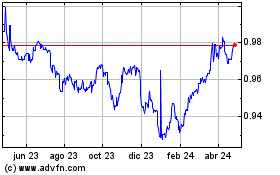ECB To Take Tapering Route Beyond March 2017
08 Diciembre 2016 - 2:31AM
RTTF2
The European Central Bank surprised markets on Thursday when it
announced that bond purchases will be extended till the end of next
year, which is longer-than-expected, but its pace will ease after
March.
The central bank left its key interest rates unchanged for a
sixth consecutive session, which was the final one this year, and
retained its asset purchases of EUR 80 billion a month till March
next year, but decided to reduce the size beyond that point to EUR
60 billion a month till December 2017.
Initial reactions suggested that economists and markets were be
perplexed by the decision, wondering whether the ECB President
Mario Draghi delivered more than they expected, in contrast to last
December.
Draghi's comments at the customary post-decision press
conference, set to begin at 8.30 am ET, will be closely scanned for
more clarity. He will likely face intense questioning on the 'no'
vote in Italy's referendum and the country's subsequent request for
more time to rescue the troubled Monte dei Paschi bank.
The Governing Council, led by Darghi, kept the refi rate
unchanged at a record low zero percent in the policy session held
in Frankfurt.
The deposit rate was held steady at -0.40 percent, and the
marginal lending facility rate at 0.25 percent. The rate decision
was in line with economists' expectation.
"The Governing Council continues to expect the key ECB interest
rates to remain at present or lower levels for an extended period
of time, and well past the horizon of the net asset purchases," the
bank said.
The three rates were previously lowered in March, when the size
of monthly asset purchases was also boosted by EUR 20 billion.
The bank also decided to continue its purchases under the asset
purchase programme, or APP, at the current monthly pace of EUR 80
billion until the end of March 2017.
From April 2017, the net asset purchases are set to be carried
out at a monthly pace of EUR 60 billion until the end of December
2017, or beyond, the bank said. They will be continued, if
necessary, until the Governing Council sees a sustained adjustment
in the path of inflation consistent with its inflation aim, the ECB
added.
"If, in the meantime, the outlook becomes less favorable or if
financial conditions become inconsistent with further progress
towards a sustained adjustment of the path of inflation, the
Governing Council intends to increase the programme in terms of
size and/or duration," the ECB said in a statement.
Economists had widely expected the bank to extend the asset
purchases by six months beyond March 2017, but retain the size of
the programme unchanged. They had also said that the bank was
unlikely to even mention any scale back of asset purchases, also
known as 'tapering', given the heightened political
uncertainty.
"Even without calling this tapering, the ECB just announced
tapering. It is the combination of extending and tapering that we
thought would not yet happen as it could risk an unwarranted
increase in bond yields," ING Bank economist Carsten Brzeski
said.
"A compromise resulting from increased pressure from the ECB
hawks to stop or at least reduce QE. Whether it was a wise decision
or whether the ECB could end up in a taper tantrum like the Fed did
in 2013 remains to be seen."
The net purchases will be made alongside reinvestments of the
principal payments from maturing securities purchased under the
APP, the bank said.
The Governing Council also decided to change some of the
parameters of the APP to ensure the continued smooth implementation
of the Eurosystem's asset purchases, the ECB said. These will be
communicated at today's press conference and in a separate press
release.
"As it had always been expected to taper after September, the
decision to slow the pace from March implies a slightly less
supportive stance than had been assumed," Capital Economics
economist Jennifer McKeown said.
"In all, we see a significant chance that the ECB will have to
increase the pace of its asset purchases again next year. And even
if it does not, policy will be far more supportive than in the US,
leading the euro to depreciate further."
Euro vs CHF (FX:EURCHF)
Gráfica de Divisa
De Mar 2024 a Abr 2024

Euro vs CHF (FX:EURCHF)
Gráfica de Divisa
De Abr 2023 a Abr 2024
